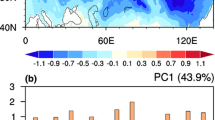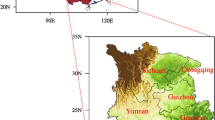Abstract
The persistence barrier of sea surface temperature anomalies (SSTAs) in the North Pacific was investigated and compared with the ENSO spring persistence barrier. The results show that SSTAs in the central western North Pacific (CWNP) have a persistence barrier in summer: the persistence of SSTAs in the CWNP shows a significant decline in summer regardless of the starting month. Mechanisms of the summer persistence barrier in the CWNP are different from those of the spring persistence barrier of SSTAs in the central and eastern equatorial Pacific. The phase locking of SSTAs to the annual cycle does not explain the CWNP summer persistence barrier.
Remote ENSO forcing has little linear influence on the CWNP summer persistence barrier, compared with local upper-ocean process and atmospheric forcing in the North Pacific. Starting in wintertime, SSTAs extend down to the deep winter mixed layer then become sequestered beneath the shallow summer mixed layer, which is decoupled from the surface layer. Thus, wintertime SSTAs do not persist through the following summer. Starting in summertime, persistence of summer SSTAs until autumn can be explained by the atmospheric forcing through a positive SSTAs-cloud/radiation feedback mechanism because the shallow summertime mixed layer is decoupled from the temperature anomalies at depth, then the following autumn-winter-spring, SSTAs persist. Thus, summer SSTAs in the CWNP have a long persistence, showing a significant decline in the following summer. In this way, SSTAs in the CWNP show a persistence barrier in summer regardless of the starting month.
Similar content being viewed by others
References
Alexander, M. A., and C. Deser, 1995: A mechanism for the recurrence of wintertime midlatitude SST anomalies. J. Phys. Oceanogr., 25, 122–137.
Alexander, M. A., and J. D. Scott, 2001: Winter-to-winter recurrence of sea surface temperature, salinity and mixed layer depth anomalies. Prog. Oceanogr., 49, 41–61.
An, S.-I., and B. Wang, 2000: Interdecadal change of the structure of the ENSO mode and its impact on the ENSO frequency. J. Climate, 13, 2044–2055.
An, S. I., and B. Wang, 2005: The forced and intrinsic low-frequency modes in the North Pacific. J. Climate, 18, 876–885.
Ashok, K., S. K. Behera, S. A. Rao, H. Weng, and T. Yamagata, 2007: El Ni≈no Modoki and its possible teleconnection. J. Geophys. Res., 112(C11007), doi: 10.1029/2006JC003798.
Cayan, D. R., 1992: Latent and sensible heat flux anomalies over the northern oceans: Driving the sea surface temperature. J. Phys. Oceanogr., 22, 859–881.
Chen, J. M., T. Li, and C. F. Shih, 2007: Fall persistence barrier of sea surface temperature in the South China Sea associated with ENSO. J. Climate, 20, 158–172.
Clarke, A. J., and S. van Gorder, 1999: The connection between the boreal spring Southern Oscillation PB and biennial variability. J. Climate, 12, 610–620.
Davis, R. E., 1978: Predictability of sea level pressure anomalies over the North Pacific Ocean. J. Phys. Oceanogr., 8, 233–246.
Deser, C., and M. L. Blackmon, 1995: On the relationship between tropical and North Pacific sea surface temperature variations. J. Climate, 8, 1677–1680.
Deser, C., M. A. Alexander, and M. S. Timlin, 2003: Understanding the persistence of sea surface temperature anomalies in midlatitudes. J. Climate, 16, 57–72.
Ding, R., and J. Li, 2009: Decadal and seasonal dependence of North Pacific sea surface temperature persistence. J. Geophys. Res., 114 (D01105), doi: 10.1029/2008JD010723.
Ding, R., and J. Li, 2011: Winter persistence barrier of sea surface temperature in the northern tropical Atlantic associated with ENSO. J. Climate, 24, doi: 10.1175/2011JCLI3784.1.
Duan, W. S., and R. Zhang, 2010: Is model parameter error related to a significant spring predictability barrier for El Niño events? Results from a theoretical model. Adv. Atmos. Sci., 27, 1003–1013, doi: 10.1007/s00376-009-9166-4.
Duan, W. S., X. Liu, K. Y. Zhu, and M. Mu, 2009: Exploring initial errors that cause a significant spring predictability barrier for El Niño events. J. Geophys. Res., 114 (C04022), doi: 10.1029/2008JC004925.
Frankignoul, C., 1985: Sea surface temperature anomalies, planetary waves and air-sea feedback in middle latitudes. Rev. Geophys., 23, 357–390.
Frankignoul, C., and K. Hasselmann, 1977: Stochastic climate models. Part 2. Application to sea-surface temperature variability and thermocline variability. Tellus, 29, 289–305.
Hanawa, K., and S. Sugimoto, 2004: “Reemergence” areas of winter sea surface temperature anomalies in the world’s oceans. Geophys. Res. Lett., 31, L10303, doi: 10.1029/2004GL019904.
Kalnay, E., and Coauthors, 1996: The NCEP/NCAR 40-year reanalysis project. Bull. Amer. Meteor. Soc., 77, 437–471.
Kao, H.-Y., and J. Y. Yu, 2009: Contrasting eastern-Pacific and Central-Pacific types of El Niño. J. Climate, 22, 615–632.
Kara, A. B., P. A. Rochford, and H. E. Hurlburt, 2003: Mixed layer depth variability over the global ocean. J. Geophys. Res., 108(C3), 3079, doi: 10.1029/2000JC000736.
Kug, J. S., F. F. Jin, and S. I. An, 2009: Two types of El Niño events: Cold tongue El Niño and warm pool El Niño. J. Climate, 22, 1499–1515.
Kushnir, Y., and N.-C. Lau, 1992: The general circulation model response to a North Pacific SST anomaly: Dependence on time scale and pattern polarity. J. Climate, 5, 271–283.
Lau, K. M., and S. Yang, 1996: The Asian monsoon and predictability of the tropical ocean-atmosphere system. Quart. J. Roy. Meteor. Soc., 122, 945–957.
Lau, N. C., and M. J. Nath, 1990: A general circulation model study of the atmospheric response to extratropical SST anomalies observed in 1950–79. J. Climate, 3, 965–989.
Lau, N. C., and M. J. Nath, 1996: The role of the “atmospheric bridge” in linking tropical Pacific ENSO events to extratropical SST anomalies. J. Climate, 9, 2036–2057.
Mantua, J. N., S. R. Hare, Y. Zhang, J. M. Wallace, and R. C. Francis, 1997: A Pacific interdecadal climate oscillation with impacts on salmon production. Bull. Am. Meteorol. Soc., 78, 1069–1079, doi: 10.1175/1520-0477(1997)078〈1069:APICOW〉2.0.CO;2
Miller, A. J., and N. Schneider, 2000: Interdecadal climate regime dynamics in the North Pacific Ocean: Theories, observations and ecosystem impacts. Prog. Oceanogr., 47, 257–260.
Monterey, G. I., and S. Levitus, 1997: Seasonal variability of mixed layer depth for the world ocean. NOAA Atlas NESDIS 14, US Gov. Printing Office, Washington, DC., 92pp.
Mu, M., H. Xu, and W. S. Duan, 2007: A kind of initial errors related to “spring predictability barrier” for El Niño events in Zebiak-Cane Model. Geophys. Res. Lett., 34 (L03709), doi: 10.1029/2006GL-27412.
Namias, J., and R. M. Born, 1970: Temporal coherence in North Pacific sea-surface temperature patterns. J. Geophys. Res., 75, 5952–5955.
Namias, J., and R. M. Born, 1974: Further studies of temporal coherence in North Pacific sea surface temperatures. J. Geophys. Res., 79, 797–798.
Norris, J. R., Y. Zhang, and J. M. Wallace, 1998: Role of clouds in summertime atmosphere-ocean interactions over the North Pacific. J. Climate, 11, 2482–2490.
Pan, Y. H., and A. H. Oort, 1990: Correlation analyses between sea surface temperature anomalies in the eastern equatorial Pacific and the World Ocean. Climate Dyn., 4, 191–205.
Park, S., M. A. Alexander, and C. Deser, 2006: The impact of cloud radiative feedback, remote ENSO forcing, and entrainment on the persistence of North Pacific sea surface temperature anomalies. J. Climate, 19, 6243–6261.
Rayner, N. A., D. E. Parker, E. B. Horton, C. K. Folland, L. V. Alexander, D. P. Rowell, E. C. Kent, and A. Kaplan, 2003: Global analyses of sea surface temperature, sea ice, and night marine air temperature since the late nineteenth century. J. Geophys. Res., 108(D14), 4407, doi: 10.1029/2002JD002670.
Smith, T. M., and R. W. Reynolds, 2004: Improved extended reconstruction of SST (1854–1997). J. Climate, 17, 2466–2477.
Torrence, C., and P. J. Webster, 1998: The annual cycle of persistence in the El Niño/Southern Oscillation. Quart. J. Roy. Meteor. Soc., 124, 1985–2004.
Trenberth, K., and D. J. Shea, 1987: On the evolution of the Southern Oscillation. Mon. Wea. Rev., 115, 3078–3096.
Trenberth, K. E., G. W. Branstator, D. Karoly, A. Kumar, N.-C. Lau, and C. Ropelewski, 1998: Progress during TOGA in understanding and modeling global teleconnections associated with tropical sea surface temperatures. J. Geophys. Res., 103, 14291–14324.
Troup, A. J., 1965: The “southern oscillation”. Quart. J. Roy. Meteor. Soc., 91, 490–506.
Uppala, S. M., and Coauthors, 2005: The ERA-40 reanalysis. Quart. J. Roy. Meteor. Soc., 612, 2961–3012.
Wajsowicz, R. C., 2005: Potential predictability of tropical Indian Ocean SST anomalies. Geophys. Res. Lett., 32 (L24702), doi: 10.1029/2005GL024169.
Wallace, J. M., C. Smith, and Q. Jiang, 1990: Spatial patterns of atmosphere-ocean interaction in the northern winter. J. Climate, 3, 990–998.
Webster, P. J., and S. Yang, 1992: Monsoon and ENSO: Selectively interactive systems. Quart. J. Roy. Meteor. Soc., 118, 877–925.
White, W. B., 1995: Design of a global observing system for gyrescale upper ocean temperature variability. Prog. Oceanogr., 36, 169–217.
Wright, P. B., 1979: Persistence of rainfall anomalies in the central Pacific. Nature, 277, 371–374.
Wu, R., and J. L. Kinter, 2010: Atmosphere-ocean relationship in the midlatitude North Pacific: Seasonal dependence and east-west contrast. J. Geophys. Res., 115, D06101, doi: 10.1029/2009JD012579.
Xiao, D., and J. Li, 2007: Spatial and temporal characteristics of the decadal abrupt changes of global atmosphere-ocean system in the 1970s. J. Geophys. Res., 112 (D24S22), doi: 10.1029/2007JD008956.
Xiao, D., J. Li, and P. Zhao, 2011: Four-dimensional structures and physical process of the decadal abrupt changes of the northern extratropical oceanatmosphere system in 1980s. Int. J. Climatol., 31, doi: 10.1002/joc.2326.
Xue, Y., M. A. Cane, S. E. Zebiak, and M. B. Blumenthal, 1994: On the prediction of ENSO: A study with a low-order Markov model. Tellus, 46, 512–528.
Yeh, S.-W., J. S. Kug, B. Dewitte, M. H. Kwon, B. P. Kirtman, and F. F. Jin, 2009: El Niño in a changing climate. Nature, 461, 511–514.
Yu, J. Y., 2005: Enhancement of ENSO’s PB by biennial variability in a coupled atmosphere-ocean general circulation model. Geophys. Res. Lett., 32 (L113707), doi: 10.1029/2005GL023406.
Yu, J. Y., H. Y. Kao, T. Lee, and S. T. Kim, 2011: Subsurface ocean temperature indices for central-Pacific and eastern-Pacific types of El Niño and La Niña events. Theor. Appl. Climatol., 103, 337–344.
Zhang, Y., J. M. Wallace, and N. Iwasaka, 1996: Is climate variability over the North Pacific a linear response to ENSO? J. Climate, 9, 1468–1478.
Zhang, Y., J. M. Wallace, and D. S. Battisti, 1997: ENSO-like interdecadal variability: 1900–93. J. Climate, 10, 1004–1020.
Zhang, Y., J. R. Norris, and J. M. Wallace, 1998: Seasonality of large scale atmosphere-ocean interaction over the North Pacific. J. Climate, 11, 2473–2481.
Zhao, X., and J. Li, 2009: Possible causes for the persistence barrier of SSTA in the South China Sea and the vicinity of Indonesia. Adv. Atmos. Sci., 26, 1125–1136, doi: 10.1007/s00376-009-8165-9.
Zhao, X., and J. Li, 2010: Winter-to-winter recurrence of SSTA in the Northern Hemisphere. J. Climate, 23, 3835–3854, doi: 10.1175/2009JCLI2583.1.
Zhao, X., and J. Li, 2012: Winter-to-winter recurrence and non-winter-to-winter recurrence of SST anomalies in the central North Pacific. J. Geophys. Res, 117, C05027, doi: 10.1029/2011JC007845.
Author information
Authors and Affiliations
Corresponding author
Rights and permissions
About this article
Cite this article
Zhao, X., Li, J. & Zhang, W. Summer persistence barrier of sea surface temperature anomalies in the central western north pacific. Adv. Atmos. Sci. 29, 1159–1173 (2012). https://doi.org/10.1007/s00376-012-1253-2
Received:
Revised:
Published:
Issue Date:
DOI: https://doi.org/10.1007/s00376-012-1253-2




